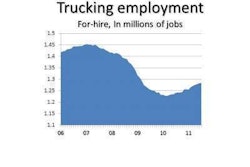FMCSA wants to release driver safety data
Agency seeking regulatory authority over drivers in highway bill
The Federal Motor Carrier Safety Administration wants authority to release driver safety data, in effect reversing its earlier stance that drivers would not be ranked publicly under the Compliance Safety Accountability program. The agency is seeking increased regulatory authority over drivers via the next highway reauthorization bill, according to a February Government Accountability Office report to Congress on CSA progress. “If [FMCSA] gains this authority,” the report reads, “the agency plans to make driver safety data public.”
Asked if the intention was to create a public driver ranking system similar to the agency’s CSA motor carrier percentile ranking system, FMCSA spokeswoman Candice Tolliver said, “The Department of Transportation is committed to working with Congress to address this issue as part of a comprehensive push to update transportation programs and maintain the highest standards of safety for the American public.”
The agency intended years ago to go public with driver data, said John Hill, FMCSA administrator from 2006 to 2008. “There was a debate among the lawyers in the agency [about if] … the agency had the authority to actually rate drivers,” Hill said. “We thought we’d make it a part of the next highway bill. We wanted to make sure there was authority to do so, and so would minimize any lawsuits that might arise from some interested party that would not agree with rating drivers.”
Currently, drivers are not ranked against their peers in the Behavioral Analysis and Safety Improvement Categories, and data from drivers’ inspection histories only is accessible officially by prospective employers through the Pre-Employment Screening Program. FMCSA has contended the Driver Safety Measurement System is an internal tool that will be used only by agency staff during carrier investigations. “Under CSA, individual CMV drivers are not assigned safety ratings,” says the CSA Website, csa.fmcsa.dot.gov.
The DSMS as a public system would reveal drivers ranked with percentile numbers against their peers and by their moving, log and equipment violations, similar to how motor carriers are ranked under CSA. The DSMS methodology, containing inspection and crash data, is available via csa.fmcsa.dot.gov, searching “DSMS methodology document.”
FMCSA’s recently released draft of its 2011-2016 regulatory plan makes no specific mention of the DSMS. The plan does refer to continuing development of “a methodology to assess the safety fitness of drivers to further identify unsafe drivers who should not be in the industry.” That process is not mentioned, however, in the anticipated outcomes listed in the strategic plan, suggesting achieving the goal could be more than five years away. – Todd Dills
IN BRIEF
* The Federal Motor Carrier Safety Administration proposed to amend the physical qualifications for drivers and the instructions for the medical examination report to clarify that drivers may not use Schedule I drugs and be qualified to drive commercial motor vehicles under any circumstances. The proposal also harmonizes FMCSA’s provisions regarding pre-employment and return-to-duty test refusals with corresponding Department of Transportation-wide provisions.
* Bendix Commercial Vehicle Systems announced its support of The Commercial Motor Vehicle Advanced Safety Technology Act of 2011 (S. 1233 and H.R. 1706), legislation that would provide a tax credit equal to 50 percent of the cost of any qualified commercial vehicle safety system that is placed into service during the tax year.
* FMCSA plans to assess CMV drivers’ expectations, attitudes and acceptance of an onboard monitoring system as part of a field operational test study. FMCSA plans for 500 CMV drivers to participate in a questionnaire.
* Results from Roadcheck 2011, the three-day commercial vehicle safety enforcement and education campaign organized annually by the Commercial Vehicle Safety Alliance, reveal that the commercial motor carrier and motorcoach industries continue to improve the maintenance and safety of their operations, with overall out-of-service rates being the lowest since Roadcheck began in 1991.
* FMCSA ordered Georgia-based H & W Tour Inc. off the road for violations “so widespread as to demonstrate a continuing and flagrant general disregard” for the safety of its passengers and the motoring public. The agency also ordered Pennsylvania-based Mr. Ho Charter Service off the road for multiple drug and alcohol testing violations and for failing to comply with hours-of-service regulations.
Research shows enforcement cuts distracted driving
The U.S. Department of Transportation announced dramatic reductions in distracted driving in Syracuse, N.Y., and Hartford, Conn., after two pilot projects measured the effect of increased law enforcement coupled with high-profile public education campaigns.
“These findings show that strong laws, combined with highly-visible police enforcement, can significantly reduce dangerous texting and cell phone use behind the wheel,” says U.S. Transportation Secretary Ray LaHood.
Each program, which was supported by $200,000 in federal funds and $100,000 from the state, examined whether increased police enforcement along with paid advertising and news media coverage could reduce distracted driving.
During four periods of stepped-up enforcement over the past year, Syracuse police issued 9,587 citations for driver violations involving talking or texting on cell phones while operating a vehicle. During the same period, police in Hartford issued 9,658 tickets for illegal phone use. Before and after each enforcement wave, the National Highway Traffic Safety Administration actively observed cell phone use and conducted public awareness surveys at driver licensing offices in the two cities, which found:
• In Syracuse, because of high-visibility enforcement, both handheld cell phone use and texting behind the wheel have declined by one-third; and
• In Hartford, where researchers initially identified drivers talking on their cell phones at twice the frequency (which left more room for improvement), there was a 57 percent drop in handheld use, and texting behind the wheel dropped by nearly three-quarters.
NHTSA plans to test this same three-part formula – tough laws, strong enforcement and ongoing public awareness – at the statewide level.
Preventable or Not
Doe deals with snack attack
Soothed by old Willie Nelson’s gravel-voiced rendition of “On The Road Again,” trucker John Doe proceeded down Route 99 toward his next delivery stop, at Perky’s Pancake House. It was dawn, with the sun rising slowly in a cloudless sky, and Doe’s tractor-trailer was just about the only vehicle on the road. After arriving at Perky’s, Doe saw the restaurant was not yet open for the day’s business, with its parking lot empty … except for a small blue Toyota.
Doe figured it probably was the manager’s car until he spied a would-be patron peering hungrily through the restaurant’s front window. Indeed, the car belonged to ravenous Rachael Rathbone, who’d arrived 30 minutes too early for Strawberry Delight Hotcakes and black coffee. Doe returned to the task at hand and began backing blindly to the left and into Perky’s parking lot.
At the same time, the frustrated Rathbone, suffering from caffeine withdrawal, decided to abandon Perky’s and drive up Route 99 to the International House of Waffles, which already was open. Preoccupied with gaining access to food, Rathbone began to blindly back out of her parking space … WHAMMO!!! … and directly into the path of Doe’s trailer, damaging her trunk.
Doe later contested the preventable-accident warning letter he received from his safety director, saying Rathbone had backed into him. Asked to settle the dispute, the National Safety Council’s Accident Review Committee upheld the preventable decision, noting that Doe knew the store was closed and should have anticipated Rathbone’s possible departure. Doe should have sounded his horn to alert Rathbone before backing into the occupied parking area, NSC ruled.












